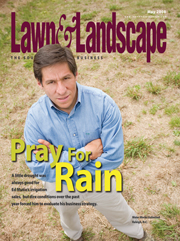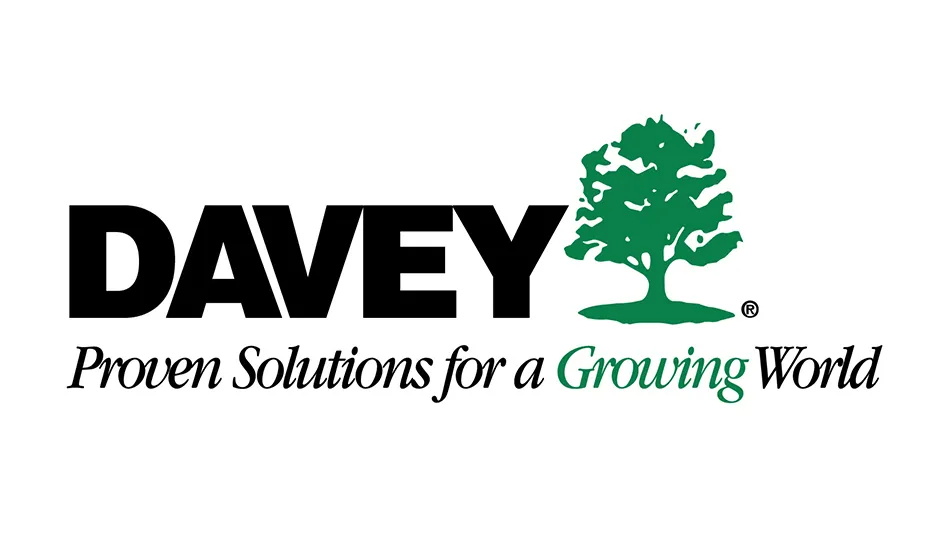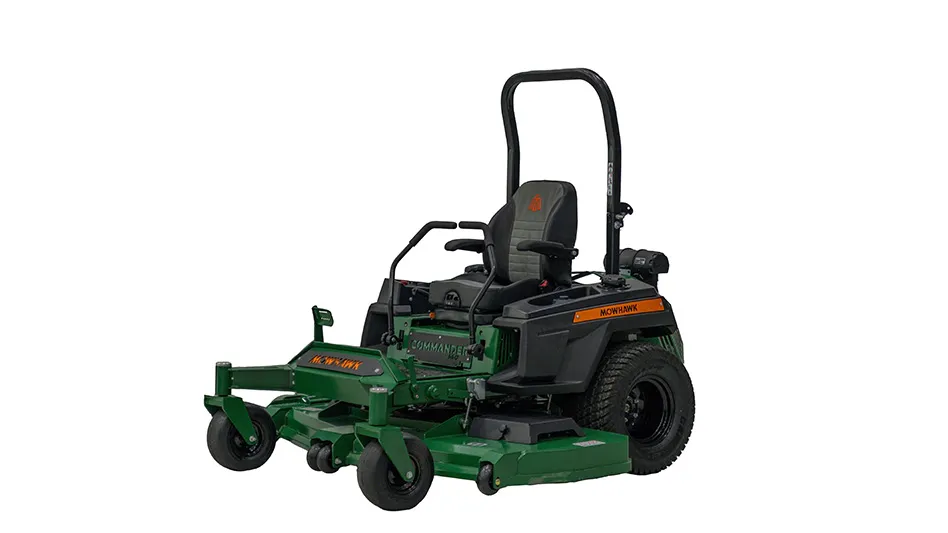“Organic” is everywhere. Like its sister words “green,” “eco-friendly” and “natural,” it’s a trendy topic these days considering the public’s renewed environmental awakening.
The lawn care industry isn’t exempt from this trend. “It’s a reflection of interest in all things ‘green’ today,” says Bruce Butterfield, the National Gardening Association’s research director, pointing to the public’s increased interest in climate change, health foods and conservation issues.
Though no figures are available on the size and growth rate of the organic and natural professional lawn care market, Butterfield expects the NGA’s updated and expanded organic market research report, due out this summer, to show a significant number of homeowners interested in using organic or natural lawn care services.
Not surprisingly, businesses have recognized they can capitalize on the popularity of the “green” market, also known as the LOHAS, or “lifestyles of health and sustainability” market, which is estimated to be a $209 billion industry in the U.S. In addition, marketers expect the LOHAS market to grow as headlines give consumers reasons to be wary of many products and services they’ve always understood to be safe. Consider last year’s pet food scare and multiple toy recalls, says John Harrison, marketing manager for Millville, N.J.-based The Espoma Co., a manufacturer of natural and organic pesticides and fertilizers. “These stories, though specialized in their scope, make a tremendous splash,” he says. “People start asking questions about everything they use in and around their homes. That spills over to ‘What’s the guy taking care of my lawn using?’”
INDUSTRY EFFORTS. Both independent and national green industry firms are offering – or investigating how to offer – organic or natural alternatives to traditional, synthetic-chemical based lawn care programs. Some companies feel they don’t have a choice. “If we’re going to remain a viable business, we were going to have to move that way,” says Randy Mock, vice president of production and sales for Washington Tree Service in Shoreline, Wash., which has offered natural lawn and tree programs for two years. “Everything people see and read is anti-pesticide. We’re forced into making a move into organics, whether it’s right or wrong.”
Some firms, like the national Spring-Green franchise, which is debuting a systemwide organic-based program this year, simply want to offer a choice. “We don’t expect any organic explosion,” says CEO Tom Hofer. He’s anticipating this service to make up less than 5 percent of companywide sales for 2008. “It’s just an option we can easily offer to a segment of the market it appeals to.”
Others don’t see a need at this point. Allen Smith, president of Delaware, Ohio-based Smith’s Lawn Services, offered a program with natural organic fertilizers several years ago, but has since dropped it and isn’t hurting. “Out of all the calls I got last year, probably around 300, I only turned away one customer because he wanted organic,” Smith says.
On the other hand, some professionals are adding these options because they’re required to seek organic/natural alternatives. Consider lawn care companies in Canada, where close to 140 municipalities have pesticide-restricting laws. The Weed Man franchise’s Canadian operation sells a menu of organic/natural services through its Nature’s Touch offerings. There is no “organic program” per se, says Chris Lemcke, national technical coordinator, but clients choose which options work best based on their preferences and their municipalities’ restrictions.
Though pesticide restrictions can be difficult to navigate at times, Lemcke sees a business opportunity with the rise of organic/natural lawn care. “With organics, most homeowners don’t understand or have the time to figure out what works and what doesn’t,” he says. This segment may provide the opportunity for professionals to truly highlight their turfgrass expertise, he says, adding it eliminates the “competition” from consumer weed-and-feed products. “If customers don’t have the choice to go to the store and buy the traditional quick-fix products off the shelf, our industry should have no problem keeping and gaining new customers.”
CAUSING CONFUSION? While terms like “organic” and “natural” are attention-grabbing and may be a boon for business, they’re also nebulous and potentially problematic in markets like the lawn care industry where they’re somewhat unregulated.
From a products standpoint, government agencies do restrict which pesticides and fertilizers may be labeled organic. (For more information, see “Product Labeling Basics” on page 70.) There is not, however, a body that officially regulates what firms that provide organic/natural lawn care may call their services. The result is a confusing mix of lawn care programs with names that include “safe,” “organic,” “natural,” “green” and “organic-based.”
At Washington Tree Service, the staff carefully developed its natural lawn care program using only products approved by the state department of agriculture for organic food production. “We use these standards so if someone questions what we’re using, we have some legitimacy,” Mock says. “This area hasn’t really been defined. Some companies are claiming they’re doing natural or organic, but they’re using products containing urea.”
Industry members suspect it’s only a matter of time until the government begins to regulate these terms in the lawn care industry. Despite the U.S. Department of Agriculture’s oversight of such terms for food production and the EPA’s hand in regulating pesticides, Phil Catron, president of Frederick, Md.-based NaturaLawn of America, speculates such restrictions would come down from the Federal Trade Commission. “They control marketing, advertising and what you can and can’t say,” he says.
IN PRACTICE. In the meantime, the Northeast Organic Farming Association (NOFA) is one group that’s working to promote organic lawn care practices based on the tenets of the organic agriculture movement. Over the last decade, the group has accredited 406 professionals through its Organic Land Care Program. The program’s popularity is rising, notes the Connecticut chapter’s Executive Director Bill Duesing. Nearly 200 professionals earned accreditation in early 2008 alone.
The group’s definitions of “organic” are clear: One of its primary goals is eliminating the use of synthetic pesticides and synthetic fertilizers. However, its standards don’t prohibit accredited members from offering both organic and traditional services (as long as chemical applications aren’t made out of trucks labeled “organic”). Also, the standards permit “emergency” applications of synthetic chemicals.
Some firms practice organic lawn care in this strict sense, but many have gone the menu or hybrid route, which may include using “bridge” fertilizers – which have elements of both organic and synthetic materials – or periodic synthetic herbicide applications. (See sidebar “The Organic-Synthetic Spectrum” on page 63.)
Todd Harrington, founder of Safe Lawns & Landscapes, Bloomfield, Conn., is an organic lawn care practitioner in the NOFA mold. A 30-year veteran of the green industry, Harrington entered the organics segment when he founded his own company 20 years ago with an interest in focusing on the chemistry and biology of soils and long-term plant management. In addition, Harrington wanted to develop a high-end niche. No other firms were taking the truly organic approach, which he says typically costs 30 to 50 percent more than traditional lawn care, and he felt – and still does – that organics was the way of the future. (Harrington has recently joined with activist Paul Tukey, founder of the anti-pesticide SafeLawns organization, to franchise his business.)
Other firms struggle to provide organic lawn care because of cost, timing and efficacy concerns. Some lawn care professionals, like Smith, say they struggle to charge their clients twice as much for programs that don’t entirely eradicate weeds or take as many as three seasons to achieve an acceptable quality level. When he offered an organic program several seasons ago, it was unsuccessful because the natural organic fertilizer did not work quickly enough and there was no affordable weed control option. “It comes down to results, and the bottom line is if you’re dealing with high-end homeowners, if the lawn isn’t thick and green, you’re fired,” Smith says.
Smith doesn’t think not offering an organic program will hurt his business. He’s confident in the safety of the products he uses and in the fact that he’s a responsible operator who operates with an IPM approach that builds healthy turf, which doesn’t require excessive use of pesticides. “It’s always been my approach to defend what [lawn care professionals] do because I believe that what we do, if we do it responsibly, is good for the environment.”
The NaturaLawn franchise, with $33 million in sales in 2007, bridges the totally organic and traditional programs with a service it calls “organic-based.” “To be successful in this area, you have to give customers results and be price competitive,” Catron says. To achieve this balance while reducing the number of synthetic chemicals introduced into the environment, Catron – a former ChemLawn regional manager – developed an approach that’s heavy on IPM, biological components (like milky spore and nematodes) and biorational products (like neem oil and insecticidal soaps). NaturaLawn does, on occasion, spot treat with synthetic herbicides. The NaturaLawn approach reduces the number of control products used by 80 to 90 percent, Catron says. He also touts the company’s cancellation and service call rates, which are less than 15 percent and 10 percent, respectively.
Lawn Doctor, the Holmdel, N.J.-based lawn care franchise system, has offered a “natural” lawn care program for 20 years. Only about 2 percent of Lawn Doctor customers opt for the Natural Program, which uses an all natural fertilizer and does not include weed or insect controls as part of the program, though the company will treat with synthetics at a customer’s request, says John Buechner, director of technical services. He says this segment of Lawn Doctor’s clientele remains small because the results are not equivalent to the traditional program, which is 40 to 50 percent less expensive. “I believe the average person who’s looking to buy lawn care is still looking to buy results,” Buechner says. “They measure that in terms of green and weed-free.”
Harrington doesn’t dispute the challenges of the organic method, but he emphasizes a cumulative, long-term approach. And, he adds, it may not be right for all firms or all customers. “You can’t just say – and this is what many of the chemical companies say, ‘Organics might not work, it’ll cost twice as much, but we’ll give you what you want,’” he says. “You have to be upfront and committed to the holistic approach. We educate and explain the several-season transition so [customers] can decide if this is something they want to do.”
At any rate, professionals agree consumers want to have a product or service they can “feel good” about, which is a moving target as this segment of the industry evolves. Some customers may truly want to eliminate synthetic fertilizer and pesticide use and pay the price; others may opt for hybrid approaches with bridge fertilizers or spot synthetic herbicide applications. Other customers will remain concerned with the quick green-up, weed-free appearance and the economical price that traditional programs offer, Harrison says. “I think there is a middle ground a lot of consumers may find themselves in.” LL

Explore the May 2008 Issue
Check out more from this issue and find you next story to read.





